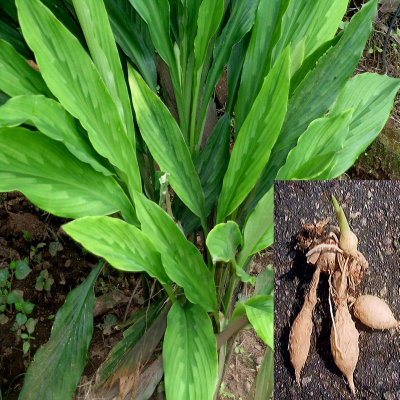Distribution and Habitat: The plant is distributed in the tropics and sub-tropics of Asia and Africa. The plant grows wild in shaded areas which are wet or humid, especially in forests in South India. It grows in gardens and is known for their beautiful flowers and foliage. It is also cultivated as an intercrop with other commercial crops.
Botany: A handsome aromatic herb with tuberous root-stalk and very short stem.
- Leaves: Simple, few, erect, oblong or ovate-lanceolate, acuminate, 30cm long, 10cm wide, variegated green above and tinged with purple below.
- Flowers: Fragrant, white, tip purple or lilac arranged in crowded spikes opening successively.
- Tuber: A subglobose tuberous rhizome from which many roots bearing small oblong or rounded tubers arise.
Properties: The tubers are acrid, thermogenic, aromatic, stomachic, anti-inflammatory, emetic and antitumour
Chemical constituents: The tubers contain crotepoxide and β-sitosterol. Tuber contains essential oil, which give a compound with melting point 149 ̊C, which yielded benzoic acid on hydrolysis.
Uses: The tubers of Indian crocus are widely used as a local application for tumours, swellings and wounds. They are also given in gastric complaints. They help to remove blood clots and other purulent matter in the body. The juice of the tubers is given in dropsical affections of hands and feet, and of effusions in joints. The drug “HALLAKAM” prepared from this is in popular use in the form of powder or as an ointment application to wounds and bruises to reduce swellings.
Formulations: Chyavanasprasam, Asokaristam, Baladthatryaditailam, Kalyanakaghritham
Agrotechnology
Soil and climate: The plant is adapted for tropical climate. Rich loamy soil having good drainage is ideal for the plant. Laterite soil with heavy organic manure application is also well suited.
Propagation: Planting is done in May-June with the receipt of 4 or 5 pre-monsoon showers. The seed rate recommended is 1500-2000 kg rhizomes/ ha. Whole or split rhizome with one healthy sprout is the planting material. Well developed healthy and disease free rhizomes with the attached root tubers are selected for planting. Rhizomes can be stored in cool dry place or pits dug under shade plastered with mud or cowdung. The field is ploughed to a fine tilth, mixed with organic manure at 10-15t/ ha. Pits are made at 20 cm spacing in which 5 cm long pieces of rhizomes are planted.
Manures and fertilizers: Pits are covered with organic manure. They are then covered with rotten straw or leaves. Apply Farm yard manure or compost as basal dose at 20 t/ ha either by broadcasting or ploughing or by covering the seed in pits after planting. Apply fertilisers at the rate of 50:50:50 kg N, P2O5 and K2O/ ha at the time of first and second weeding. After planting, mulch the beds with dry or green leaves at 15 t/ ha.
Plant control: During heavy rainy months, leaf rot occurs which can be controlled by spraying 1% Bordeaux mixture.
Harvesting: The crop can be harvested after 7 months maturity. Drying up of the leaves is the indication of maturity. Harvest the crop carefully without cutting the rhizome, remove dried leaves and roots. Wash the rhizome in water. They are stored in moisture-proof sheds.

